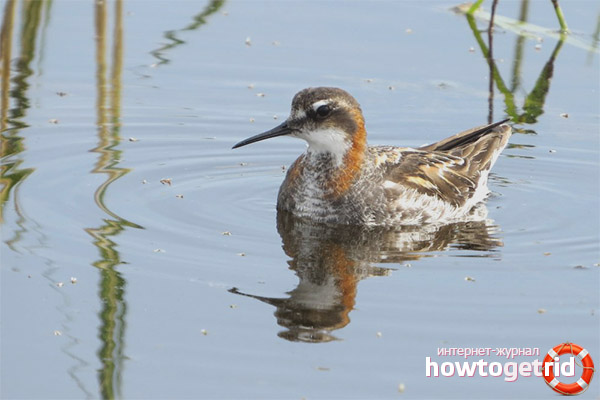The content of the article
Cyclone swimming - a species of birds belonging to the order Charadriiformes and the family of snipe. In size, these birds are quite small. Their body length reaches only 19 centimeters maximum, and body weight is usually not more than 45 grams. The wingspan varies from 32 to 41 centimeters. Today in the world there are about 95 thousand pairs of round-necked flippers.
Description of the appearance of swimmers
Cyclone swimming is the smallest of all varieties of swimming. The birds of this species have a black and thin beak, slightly compressed from the sides. Also a characteristic feature of these birds are leathery rims on the fingers. During the nesting period, birds acquire a special color. The plumage of males at this time becomes paler, gray-black, the neck and chin are of the usual white color. The neck on both sides has small parts of red feathers. Breast, as well as sides covered with gray feathers, abdomen - white. In females, the color is brighter and clearer; in winter, the plumage becomes light gray.
Where do Cyclops swim?
Divers usually equip their nests in the tundra, as well as forest-tundra. Basically, as a place to live, these birds choose the shores of lakes, as well as marshy areas. During wintering, birds move to other territories, but they can be found most often in the open sea or on the coast.
How do swimmers live and behave?
During nesting, these birds usually create colonies from a small number of individuals. Nests are mainly established in low plants, as well as in moss. As a litter, these birds use various leaves and stems. The laying period of eggs in swimmers usually falls between early May and July. On average, females lay 4 eggs per clutch, eggs have an olive tint and dark spots. After the females lay their eggs, they immediately fly south. Mostly males hatch eggs, in time this process takes up to three weeks. The brood is only one per year. After hatching, the chicks independently get their own food. After 20 days, the offspring can fly and swim independently. Males leave offspring as soon as the chicks begin to move independently. After this, broods usually break up.
A distinctive feature of this species of birds is how easily they behave in flight. In addition, swimmers love to stay on the water. The round-nosed swimmers have a very raspy voice, and they also differ in their trust. The menu of these birds is mainly invertebrates that live in water. Interestingly, these birds swim perfectly, and can also easily dive due to the rims on their fingers. The process of obtaining food is reduced to the fact that the swimmer rotates around its axis and agitates the water around it. This greatly facilitates the capture of invertebrates.
Relatives of the Cyclops
The most common relative of the round-nosed swimmers is the flat-nosed swimmer. This species is distributed mainly in the extreme Arctic region. In contrast to the round-nosed, this species of swimmers has large sizes and body weight, as well as a different color. Flat-nosed individuals are covered with chestnut and brick-colored feathers in the neck and lower body. The beak in birds has the shape of a cone, it is quite short and usually yellow. You can meet these birds occasionally in Italy during the wintering period.
Video: Cyclone swimming (Phalaropus lobatus)











Submit